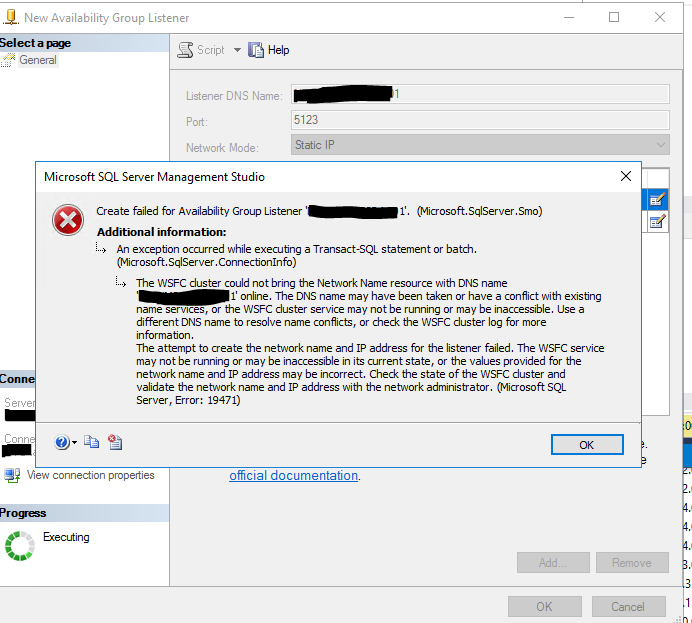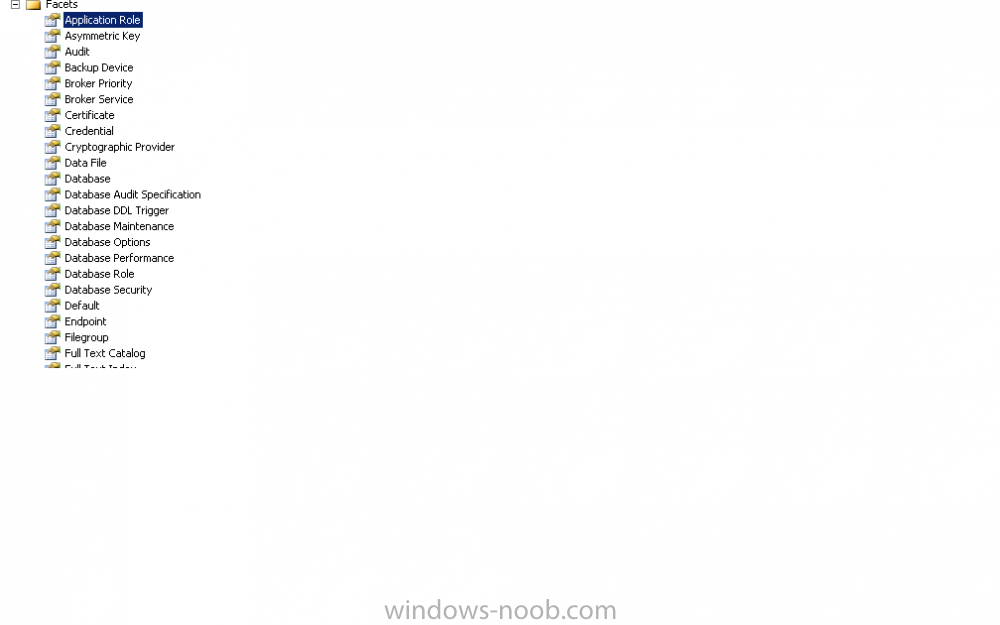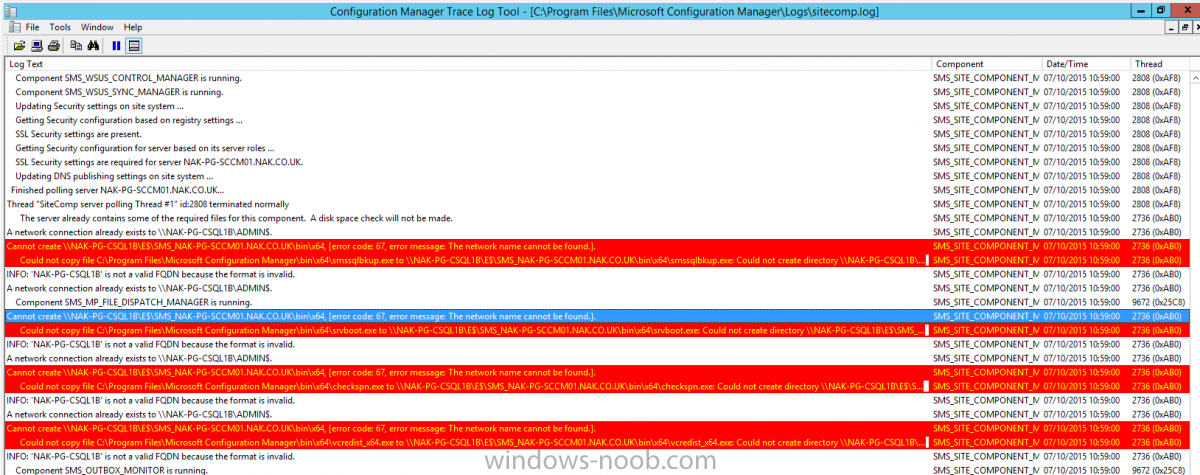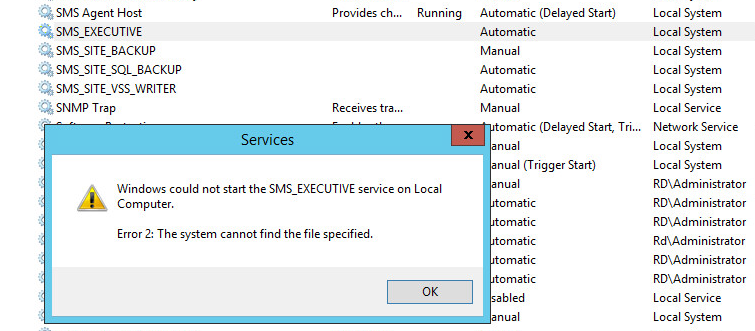Search the Community
Showing results for tags 'SQL'.
-
Hi, Has anyone come across this before? I am moving our SCCM database from SQL 2012 on a 2012r2 server to SQL 2019 on a 2019 server, by recovering from a backup. All seems to have gone fine, until the final step of running config manager setup again to choose the site maintenance option, to 'modify SQL server configuration', in order to point SCCM to the new server that is now hosting the database. ERROR: SQL Server error: [42000][137][Microsoft][SQL Server Native Client 11.0][SQL Server]Must declare the scalar variable "@String". : dbo.spCreateAndBackupSQLCert Create_BackupSQLCert : Failed to execute spCreateAndBackupSQLCert CSiteControlSetup::SetupCertificateForSSB : Failed to create/backup SQL SSB certificate. ERROR: Failed to set up SQL Server certificate for service broker on "SERVER NAME" . I have enabled broker, set trustworthy on and honor broker priority on, on the new instance before running setup.exe again. From some reading online, I believe it could be something to do with setting up SCCM initially with one account, but then changing it to another domain account running the service(s) and now somehow not being able to unlock the master key for the database certs. Sorry if this is making no sense, I am no SQL expert. Being right at the final stage of moving the database, I'm really stuck with this issue now, so any advice/pointers would be greatly welcomed, even if it's just to point me in the direction of which account I need to try to figure out was initially running things - I'm not clear whether that means the account running the config mgr console, the database instance, or the running the sql or sccm services. Thanks Paul
-
I have inherited an SCCM 2211 environment that was supposed to have been setup in HA, but it was not fully configured (no passive site node). I'm a bit stumped with how the SQL AOG has been configured and the person that built it is no longer around. In the past when setting up HA, I would setup the SQL AOG and point SCCM to the listener node. In the console I would see a single site database sever and it would use the name of the listener as the server name. In the environment I inherited, they setup an AOG, but there are 2 site database server roles in the console and they are both pointing to the 2 AOG replicas rather than the listener. I can't find anything saying this is supported and I don't see how that gets you HA capability, but before I start reconfiguring things I wanted to make sure this is not a supported method for HA with SQL and SCCM? Thanks
-
Hi All, I was wondering if someone could give me some pointers to a HowTo Guide for SQL 2016 Always-On. I've been using a guide from sqlrx.com which has brought me to a point but it's not complete idiot proof obviously as I'm stuck.. I've created the AG - Availability Group and I've both servers in but I can't figure out what the Availability Group Listener is for I assume I need it.. Current status is the Always on AG is up I have a primary server green but my secondary as a red Arrow and my Availability Databases is green. I don't expect the solution to be handed to me but a little guidance would be appreciated. Thanks in advance DG
-
Following along in the documentation, I get to where I want to install the Reporting Services Point Role. Figure no big deal. In walking through the steps of role setup everything is great until I go to dropdown the selection for the Reporting Server Instance. It does not see the reporting server instance. In looking at the SQL server, I don't see reporting services listed in the Start Menu and I selected Reporting Services on the original install. I've even gone back into SQL setup to look and SQL setup shows it is installed. Anyone have an idea?
- 29 replies
-
- SQL
- Reporting Services
-
(and 2 more)
Tagged with:
-
Hello, We are just starting down the path of SCCM and building out a DEV environment. Will install 1702 then upgrade to 1710 and then possibly 1802. Looking at the Hardware and Server requirements wondering if anyone could shed any light into their builds. There are a number of posts out there talking about the (2) different install scenarios. Do more people install SQL locally on the Primary site server or do they install it on a remote server - which could be beneficially if you're looking at clustering your SQL environment. We're currently an Oracle shop which really doesn't help us out. The other Q I have is in regards to the hardware requirements. Our PROD environment will only start off with approximately 1000 clients. Reading the MS recommendations they seem rather beefy especially if you do install the SQL server locally (16 cores / 96GB ram). Are those numbers exaggerated? Thank you ZT
-
Hi All, I hope you are well, Currently I have an issue I have unsuccessfully been battling with for a few days now. The original plan was to have the sccm db running on a sql high availability always on group setup. 1 x primary server 1 x sup server 1 x dp server 2 x sql servers when I tried to install SCCM initially, on the clustered sql, I was getting issues with listener admin rights / ports Excerpt from sccm install log --------------- CWmiRegistry::GetStr: Failed to get string value MSSQLSERVER Configuration Manager Setup 06/03/2018 16:05:16 92 (0x005C) Failed to retrieve SQL Server instance name[MSSQLSERVER]. Configuration Manager Setup 06/03/2018 16:05:16 92 (0x005C) WARNING: failed to retrieve port number for XXX-SCCM-LST.ncc.local. Configuration Manager Setup 06/03/2018 16:05:16 92 (0x005C) WARNING: failed to retrieve port number for XXX-SCCM-LST.ncc.local. Configuration Manager Setup 06/03/2018 16:05:16 92 (0x005C) ---------------- End of Excerpt XXX-SCCM-LST = sql listener this is a named instance on the sql (SCCM) and the sql port is 1433 /broker 4022 Why is it looking for MSSQLSERVER ? why failing to retrieve port ? So - I recently gave up and installed SCCM on a named server (not the listener) (SERVER-A - which is to be used in the HA cluster) sccm installs and works fine. I have installed the DB on a single box, and SCCM is looking good and functioning / patched up to 1710 + hotfix. OK - So I think I can do SCCM site maintenance, and change the DB location to the SQL Listener. But no same errors in logs again. Any one got any ideas or further experience with sql availability groups and are we missing something simple. Hope to hear back from anyone Regards, WAZZIE
-
I am in the process of upgrading our SCCM infrastructure from Svr2008R2 and SQL2008R2 to 2012R2 so I can upgrade to current branch. We are doing in-place upgrades, to 2012R2 on our Primary Site and also our separate DB server. Our DBA is going to start by upgrading our SQL version to 2014 on the box and they have asked the question where do these facets attached to the database come from and how are they generated, as the DBA plans on detaching backing up and re attaching the DB, they said these facets will not be carried over. Are these facets generated by SCCM and will they continue to exist after the version of SQL is upgraded and the database reattached?. I have attached a screenshot of the facets in question. Thanks
-
- sccm upgrade
- 1710
-
(and 1 more)
Tagged with:
-
Just a tip or something to be aware of. One of my admins pointed out they were running low on disk space on the drive where the SQL server was installed. Turns out that by default the ReportServer DB log file is set to grow to 2TB by default! Went into SSMS and changed the ReportServer DB to "simple" and then ran the "shrink" command on the log file of that DB. File went from 500+GB to 6MB. Changed to the maximum file size afterwards too so it doesn't happen again. Thought some of you might find this useful.
-
Error with Database replication link after expanding primary standalone to CAS with primary. Replicator link analyzer says the sql server boker login is missing.
-
- sccm broker
- sql
-
(and 1 more)
Tagged with:
-
I am trying to add a CAS to a stand along primary server and I get to the point where it is asking for the Path to the SQL Server data file and the Path to the SQL Server Log file, but doesn't proceed any further. If the SQL server is remote, does it still use a local C:\... path, and would it be the path on the remote server or local...SQL is installed as a default instance on another server called xwz. Won't go past screen shot below.
-
Hi All. Long time lurker here but now is the first time I have been moved to create an account and ask for some advice. I’m looking for a bit of direction on how to proceed as I’m a bit stuck, I’d like to fix this without breaking anything else in SCCM. I’m running SCCM build 1606 – Last week we upgraded the SQL instance hosting all out SCCM databases from SQL 2008 SP3 to SQL 2014 (this because we plan to upgrade to SCCM 1702). The SQL upgrade wizard reported that it upgraded all components successfully to SQL 2014 but when I opened the SCCM console all the reports are missing. Everything else in SCCM appears to be OK. Further investigation revealed. The Sql server Reporting services Service is not running - when I try and start it I get the error “ Error 2 – can’t find the service specified”. It turns out the executable it maps to named ReportingServicesService.exe does not exist in "C:\Program Files\Microsoft SQL Server\MSRS10_50.MSSQLSERVER\Reporting Services\ReportServer\bin” If I try and launch the SQL reporting services configuration manager 2008 and 2014 console it is unable find a reporting server. So I guess SQL reporting is broken. I’m wondering what I should do to try and fix this. This is what I was thinking but it’s just a guess. Remove Reporting services role from SCCM. Uninstall SQL 2008 Reporting Services feature? Uninstall SQL 2014 Reporting services Feature? Unattached the current SQL Report server and Report Temp DB databases (would I need to do this?). Reinstall SQL 2014 report services, configure reporting service point. I’d a appreciate any advice, I did have a few custom reports configured but I don’t mind setting them up again. The main thing is to get reporting services up and running again. Thanks in advance.
-
Hello all, I've ran into a few issues with SCCM 2012 R2 SP1, I have a remote 2 node SQL cluster, essentially one of the nodes failed a few months ago so it's been online for a while, during this time the SCCM DB was moved to this cluster, today the 2nd node is now online so I was expecting that SCCM was install what it needed on this server, I am however running into issues with SCCM thinking that a drive of E:\ exists in the sitecomp.log however this drive does not exist on the node, is there anyway of changing the path? or will I need to reset my SQL configuration again from the setup? Sitecomp log: Thread "SiteComp server polling Thread #1" id:2808 terminated normally $$<SMS_SITE_COMPONENT_MANAGER><10-07-2015 10:59:00.811-60><thread=2808 (0xAF8)> The server already contains some of the required files for this component. A disk space check will not be made. $$<SMS_SITE_COMPONENT_MANAGER><10-07-2015 10:59:00.831-60><thread=2736 (0xAB0)> A network connection already exists to \\NAK-PG-CSQL1B\ADMIN$. $$<SMS_SITE_COMPONENT_MANAGER><10-07-2015 10:59:00.831-60><thread=2736 (0xAB0)> ~Cannot create \\NAK-PG-CSQL1B\E$\SMS_NAK-PG-SCCM01.NAK.CO.UK\bin\x64, [error code: 67, error message: The network name cannot be found.]. $$<SMS_SITE_COMPONENT_MANAGER><10-07-2015 10:59:00.837-60><thread=2736 (0xAB0)> Could not copy file C:\Program Files\Microsoft Configuration Manager\bin\x64\smssqlbkup.exe to \\NAK-PG-CSQL1B\E$\SMS_NAK-PG-SCCM01.NAK.CO.UK\bin\x64\smssqlbkup.exe: Could not create directory \\NAK-PG-CSQL1B\E$\SMS_NAK-PG-SCCM01.NAK.CO.UK\bin\x64. The operating system reported error 0: The operation completed successfully.~~ $$<SMS_SITE_COMPONENT_MANAGER><10-07-2015 10:59:00.838-60><thread=2736 (0xAB0)> INFO: 'NAK-PG-CSQL1B' is not a valid FQDN because the format is invalid. $$<SMS_SITE_COMPONENT_MANAGER><10-07-2015 10:59:00.838-60><thread=2736 (0xAB0)> A network connection already exists to \\NAK-PG-CSQL1B\ADMIN$. $$<SMS_SITE_COMPONENT_MANAGER><10-07-2015 10:59:00.861-60><thread=2736 (0xAB0)> Component SMS_MP_FILE_DISPATCH_MANAGER is running. $$<SMS_SITE_COMPONENT_MANAGER><10-07-2015 10:59:00.864-60><thread=9672 (0x25C8)> ~Cannot create \\NAK-PG-CSQL1B\E$\SMS_NAK-PG-SCCM01.NAK.CO.UK\bin\x64, [error code: 67, error message: The network name cannot be found.]. $$<SMS_SITE_COMPONENT_MANAGER><10-07-2015 10:59:00.865-60><thread=2736 (0xAB0)> Could not copy file C:\Program Files\Microsoft Configuration Manager\bin\x64\srvboot.exe to \\NAK-PG-CSQL1B\E$\SMS_NAK-PG-SCCM01.NAK.CO.UK\bin\x64\srvboot.exe: Could not create directory \\NAK-PG-CSQL1B\E$\SMS_NAK-PG-SCCM01.NAK.CO.UK\bin\x64. The operating system reported error 0: The operation completed successfully.~~ $$<SMS_SITE_COMPONENT_MANAGER><10-07-2015 10:59:00.865-60><thread=2736 (0xAB0)> INFO: 'NAK-PG-CSQL1B' is not a valid FQDN because the format is invalid. $$<SMS_SITE_COMPONENT_MANAGER><10-07-2015 10:59:00.866-60><thread=2736 (0xAB0)> A network connection already exists to \\NAK-PG-CSQL1B\ADMIN$. $$<SMS_SITE_COMPONENT_MANAGER><10-07-2015 10:59:00.892-60><thread=2736 (0xAB0)> ~Cannot create \\NAK-PG-CSQL1B\E$\SMS_NAK-PG-SCCM01.NAK.CO.UK\bin\x64, [error code: 67, error message: The network name cannot be found.]. $$<SMS_SITE_COMPONENT_MANAGER><10-07-2015 10:59:00.897-60><thread=2736 (0xAB0)> Could not copy file C:\Program Files\Microsoft Configuration Manager\bin\x64\checkspn.exe to \\NAK-PG-CSQL1B\E$\SMS_NAK-PG-SCCM01.NAK.CO.UK\bin\x64\checkspn.exe: Could not create directory \\NAK-PG-CSQL1B\E$\SMS_NAK-PG-SCCM01.NAK.CO.UK\bin\x64. The operating system reported error 0: The operation completed successfully.~~ $$<SMS_SITE_COMPONENT_MANAGER><10-07-2015 10:59:00.897-60><thread=2736 (0xAB0)> INFO: 'NAK-PG-CSQL1B' is not a valid FQDN because the format is invalid. $$<SMS_SITE_COMPONENT_MANAGER><10-07-2015 10:59:00.898-60><thread=2736 (0xAB0)> A network connection already exists to \\NAK-PG-CSQL1B\ADMIN$. $$<SMS_SITE_COMPONENT_MANAGER><10-07-2015 10:59:00.918-60><thread=2736 (0xAB0)> ~Cannot create \\NAK-PG-CSQL1B\E$\SMS_NAK-PG-SCCM01.NAK.CO.UK\bin\x64, [error code: 67, error message: The network name cannot be found.]. $$<SMS_SITE_COMPONENT_MANAGER><10-07-2015 10:59:00.923-60><thread=2736 (0xAB0)> Could not copy file C:\Program Files\Microsoft Configuration Manager\bin\x64\vcredist_x64.exe to \\NAK-PG-CSQL1B\E$\SMS_NAK-PG-SCCM01.NAK.CO.UK\bin\x64\vcredist_x64.exe: Could not create directory \\NAK-PG-CSQL1B\E$\SMS_NAK-PG-SCCM01.NAK.CO.UK\bin\x64. The operating system reported error 0: The operation completed successfully.~~ $$<SMS_SITE_COMPONENT_MANAGER><10-07-2015 10:59:00.923-60><thread=2736 (0xAB0)> INFO: 'NAK-PG-CSQL1B' is not a valid FQDN because the format is invalid. $$<SMS_SITE_COMPONENT_MANAGER><10-07-2015 10:59:00.923-60><thread=2736 (0xAB0)> There is no E:\ Drive on NAK-PG-CSQLB Any ideas?
-
Hello, I'm new to SQL and I need help understanding the best approach to our current problem. I need to build a custom parameter-based report in Microsoft SQL Report Builder 3.0 where you select two or more collections as parameters. The report should then cross reference which computers exist in all selected collections and output their name it to the report. I have built a static query I can run against the SQL server directly, but we need to be able to dynamically select a collection for easier reporting purposes. This is the query I use: SELECT v_GS_SYSTEM.Name0 FROM v_GS_SYSTEM WHERE Name0 IN (SELECT Name from v_CM_RES_COLL_CMS0020B) AND Name0 IN (SELECT Name from v_CM_RES_COLL_CMS000D1) I don't know how to proceed in how to make the above query into a parameter report in Report Builder, or how to otherwise get what we're looking for. Does anyone know? Any help is greatly appreciated.
- 4 replies
-
- sql
- report builder
-
(and 1 more)
Tagged with:
-
As part of our companies SCCM 2012 design process, I'm tasked with attaining some network traffic modelling for a CAS design and a single Primary Site design. Scenario: 10,000 managed devices spread in over 22 locations globally 1x CAS 2x Primary Sites (5,000 devices per site) What would the estimated size of the databases be and the amount of network traffic (Primary "A" <-> CAS <-> Primary "B"). I've tried Googling for this information and couldn't find definitive numbers or even ball park numbers to do calculations. Any assistance is much appreciated.
-
Hi all, I've my lab setup running under two servers (SCCM server and SQL server). I did this to keep the environment as equal as other environments where I work with. However, I need more space (hdd) and maybe this will also help me to gain some performance. I want to install the a new instance of SQL in the SCCM Server. Is this as simply as it should or it's a big challenge?! Steps that I think are necessary: - install same SQL version in SCCM server, same collation, reporting services; - remove reporting services roles - follow all these steps https://blogs.technet.microsoft.com/configurationmgr/2013/04/02/how-to-move-the-configmgr-2012-site-database-to-a-new-sql-server/ - restart sccm server - install reporting services Is this to much or should I just refresh everything? (that's a lot of work as well)... This steps are for CM12 but since I'm using CM1511 not sure if they will work... I believe they will, but if someone has this kind of experience, I really appreciate. Thank you all!
-
Hey everyone, especially Niall, thank you so much for this community. It's been a great help! I am standing up a new SCCM 2012 R2 server and am setting it up with the plan to deploy SUS updates from SCCM (currently using a standalone WSUS server in our environment). We are running the SQL server DB for SCCM on its own server, using the default instance. I have not installed the SUS role yet on the new SCCM server. My DBA is asking me if it's OK for the SCCM and WSUS databases to share the same instance. My instinct tells me I shouldn't, but the DBA says it that if it were possible, it would save a lot of maintenance overhead. Any SCCM/SQL gurus willing to weigh in on this? I found one link on TechNet that seemed to suggest best practices for this: use the default instance for SCCM, and a named instance for WSUS. But is it necessary? Or recommended just because it's easier to determine resource utilization? Thanks everyone!
-
Hello, I am trying to move the database from a SQL 2008 R2 cluster to SQL 2014 cluster. Our current set up is: Windows 2008 r2, SCCM 2012 (cu2 only, planing to upgrade to 2012 R2 as soon as DB is working), SQL 2008 r2 SP3. I took a backup of the DB on the old cluster, restored in the new one without any issues. I left the compatibility mode on 2008 - Schema 100. I run USE master; GO ALTER DATABASE CM_PR1 SET ENABLE_BROKER GO USE master; GO ALTER DATABASE CM_PR1 SET TRUSTWORTHY ON GO USE master; GO ALTER DATABASE CM_PR1 SET HONOR_BROKER_PRIORITY ON; GO Now, run the following query to check the settings again select name, collation_name, user_access_desc, is_read_only, state_desc, is_trustworthy_on, is_broker_enabled,is_honor_broker_priority_on from sys.databases where name = 'CM_PR1' to update all parameters. Next step was to install SQL Native client 2014 on the SCCM server and run the SCCM Configuration Manager Setup. I point to new DB and after about 10 min the setup finished successfully. I started the SCCM console and to my surprise all task/boot images/OS images and programs were gone. I still had all computers/collections/drivers/applications. I tried to change the SQL compatibility mode to 2-14 but no effect. Why only part of information is displayed? Is there another DB i need to take care off? Any help will be appreciated.
-
I am attempting to write a powershell script for our 2012 SP1 environment that well ask for the input of a package ID and it will prestage its dependencies all in separate pkgx files so it is easier to tell what has already been pre-staged. Each dependency will be named by package ID. I have the logic to get the dependencies, however I noticed something. If I go to prestage a file and check the box to include dependencies, it will list the superseded packages as well. If I try to distribute content, it will only list the dependencies. While researching superscedence and content issues, I have discovered that if it is deployed via Task Sequence, it will download the supersceded application as well. So this then changes the need for my script, I now need a way to determine what applications an application supersedes through a WMI or SQL query. Does anyone have any idea where to find that? I am attempting to find it in the DBprov log now, but I was hoping someone might have that info already available.
- 1 reply
-
- SCCM
- Configuration Manager
-
(and 3 more)
Tagged with:
-
SCCM 2012 R2 Console unable to Connect its SQL 2012 Database
angurpatel posted a question in How do I ?
Trying to connect Config Manager CAS Console to its SQL database and getting error (Screenshot 1). Also SMS_EXECUTIVE and other SMS Services could not Start (Screenshot 2). Getting one of the event error as - License Activation (slui.exe) failed with the following error code: hr=0x800705B4 I can connect to other Primary Site database from CAS Console. Domain Admins and Local Administrator have all the rights in DCOM permissions. I checked the forum and tried with other options but it didn't helped. Any suggestions please? SCCM Error 1.txt SCCM Error 2.txt SCCM Error 3.txt- 7 replies
-
- SCCM 2012 R2
- SQL 2012
-
(and 7 more)
Tagged with:
-
Hi Forum, Please help! Here's the story. When we had our SCCM installed it seems that some bright spark decided to put a trial version of SQL on the server its installed on. Last week the trial ran out and reporting stopped and then no one could connect via the consoles. Our apps team fixed this and we can now log into SCCM 2012 but we cannot build any machines via PXE. Any suggestions? I've checked the SMSPXE.log and see errors: Loaded D:\Program Files (x86)\Windows Kits\8.1\Assessment and Deployment Kit\Deployment Tools\amd64\DISM\wimgapi.dll SMSPXE 24/03/2015 10:36:17 8428 (0x20EC) Opening image file D:\RemoteInstall\SMSImages\MON0006E\winpe8.MON0006E.wim SMSPXE 24/03/2015 10:36:17 8428 (0x20EC) Found Image file: D:\RemoteInstall\SMSImages\MON0006E\winpe8.MON0006E.wim PackageID: MON0006E ProductName: Microsoft® Windows® Operating System Architecture: 0 Description: Microsoft Windows PE (x86) Version: Creator: SystemDir: WINDOWS SMSPXE 24/03/2015 10:36:17 8428 (0x20EC) Closing image file D:\RemoteInstall\SMSImages\MON0006E\winpe8.MON0006E.wim SMSPXE 24/03/2015 10:36:17 8428 (0x20EC) Failed adding image D:\RemoteInstall\SMSImages\MON0006E\winpe8.MON0006E.wim. Will Retry.. Unspecified error (Error: 80004005; Source: Windows) SMSPXE 24/03/2015 10:36:17 8428 (0x20EC) Loaded D:\Program Files (x86)\Windows Kits\8.1\Assessment and Deployment Kit\Deployment Tools\amd64\DISM\wimgapi.dll SMSPXE 24/03/2015 10:38:17 8428 (0x20EC) Opening image file D:\RemoteInstall\SMSImages\MON00004\boot.MON00004.wim SMSPXE 24/03/2015 10:38:17 8428 (0x20EC) Found Image file: D:\RemoteInstall\SMSImages\MON00004\boot.MON00004.wim PackageID: MON00004 ProductName: Microsoft® Windows® Operating System Architecture: 0 Description: Microsoft Windows PE (x86) Version: Creator: SystemDir: WINDOWS SMSPXE 24/03/2015 10:38:17 8428 (0x20EC) Closing image file D:\RemoteInstall\SMSImages\MON00004\boot.MON00004.wim SMSPXE 24/03/2015 10:38:17 8428 (0x20EC) Failed adding image D:\RemoteInstall\SMSImages\MON00004\boot.MON00004.wim. Will Retry.. Unspecified error (Error: 80004005; Source: Windows) SMSPXE 24/03/2015 10:38:17 8428 (0x20EC) Loaded D:\Program Files (x86)\Windows Kits\8.1\Assessment and Deployment Kit\Deployment Tools\amd64\DISM\wimgapi.dll SMSPXE 24/03/2015 10:38:17 8428 (0x20EC) Opening image file D:\RemoteInstall\SMSImages\MON00005\boot.MON00005.wim SMSPXE 24/03/2015 10:38:17 8428 (0x20EC) Found Image file: D:\RemoteInstall\SMSImages\MON00005\boot.MON00005.wim PackageID: MON00005 ProductName: Microsoft® Windows® Operating System Architecture: 9 Description: Microsoft Windows PE (x64) Version: Creator: SystemDir: WINDOWS SMSPXE 24/03/2015 10:38:17 8428 (0x20EC) Closing image file D:\RemoteInstall\SMSImages\MON00005\boot.MON00005.wim SMSPXE 24/03/2015 10:38:17 8428 (0x20EC) Failed adding image D:\RemoteInstall\SMSImages\MON00005\boot.MON00005.wim. Will Retry.. Unspecified error (Error: 80004005; Source: Windows) SMSPXE 24/03/2015 10:38:17 8428 (0x20EC) Loaded D:\Program Files (x86)\Windows Kits\8.1\Assessment and Deployment Kit\Deployment Tools\amd64\DISM\wimgapi.dll SMSPXE 24/03/2015 10:38:17 8428 (0x20EC) Opening image file D:\RemoteInstall\SMSImages\MON00006\WinPE.MON00006.wim SMSPXE 24/03/2015 10:38:17 8428 (0x20EC) Found Image file: D:\RemoteInstall\SMSImages\MON00006\WinPE.MON00006.wim PackageID: MON00006 ProductName: Microsoft® Windows® Operating System Architecture: 0 Description: Microsoft Windows PE (x86) Version: Creator: SystemDir: WINDOWS SMSPXE 24/03/2015 10:38:17 8428 (0x20EC) Closing image file D:\RemoteInstall\SMSImages\MON00006\WinPE.MON00006.wim SMSPXE 24/03/2015 10:38:17 8428 (0x20EC) Failed adding image D:\RemoteInstall\SMSImages\MON00006\WinPE.MON00006.wim. Will Retry.. Unspecified error (Error: 80004005; Source: Windows) SMSPXE 24/03/2015 10:38:17 8428 (0x20EC) Loaded D:\Program Files (x86)\Windows Kits\8.1\Assessment and Deployment Kit\Deployment Tools\amd64\DISM\wimgapi.dll SMSPXE 24/03/2015 10:38:17 8428 (0x20EC) Opening image file D:\RemoteInstall\SMSImages\MON00007\WinPE.MON00007.wim SMSPXE 24/03/2015 10:38:17 8428 (0x20EC) Found Image file: D:\RemoteInstall\SMSImages\MON00007\WinPE.MON00007.wim PackageID: MON00007 ProductName: Microsoft® Windows® Operating System Architecture: 9 Description: Microsoft Windows PE (x64) Version: Creator: SystemDir: WINDOWS SMSPXE 24/03/2015 10:38:17 8428 (0x20EC) Closing image file D:\RemoteInstall\SMSImages\MON00007\WinPE.MON00007.wim SMSPXE 24/03/2015 10:38:17 8428 (0x20EC) Failed adding image D:\RemoteInstall\SMSImages\MON00007\WinPE.MON00007.wim. Will Retry.. Unspecified error (Error: 80004005; Source: Windows) SMSPXE 24/03/2015 10:38:17 8428 (0x20EC) Loaded D:\Program Files (x86)\Windows Kits\8.1\Assessment and Deployment Kit\Deployment Tools\amd64\DISM\wimgapi.dll SMSPXE 24/03/2015 10:38:17 8428 (0x20EC) Opening image file D:\RemoteInstall\SMSImages\MON0000E\winpe.MON0000E.wim SMSPXE 24/03/2015 10:38:17 8428 (0x20EC) Found Image file: D:\RemoteInstall\SMSImages\MON0000E\winpe.MON0000E.wim PackageID: MON0000E ProductName: Microsoft® Windows® Operating System Architecture: 0 Description: Microsoft Windows PE (x86) Version: Creator: SystemDir: WINDOWS SMSPXE 24/03/2015 10:38:17 8428 (0x20EC) Closing image file D:\RemoteInstall\SMSImages\MON0000E\winpe.MON0000E.wim SMSPXE 24/03/2015 10:38:17 8428 (0x20EC) Failed adding image D:\RemoteInstall\SMSImages\MON0000E\winpe.MON0000E.wim. Will Retry.. Unspecified error (Error: 80004005; Source: Windows) SMSPXE 24/03/2015 10:38:17 8428 (0x20EC) Loaded D:\Program Files (x86)\Windows Kits\8.1\Assessment and Deployment Kit\Deployment Tools\amd64\DISM\wimgapi.dll SMSPXE 24/03/2015 10:38:17 8428 (0x20EC) Opening image file D:\RemoteInstall\SMSImages\MON0000F\winpe.MON0000F.wim SMSPXE 24/03/2015 10:38:17 8428 (0x20EC) Found Image file: D:\RemoteInstall\SMSImages\MON0000F\winpe.MON0000F.wim PackageID: MON0000F ProductName: Microsoft® Windows® Operating System Architecture: 9 Description: Microsoft Windows PE (x64) Version: Creator: SystemDir: WINDOWS SMSPXE 24/03/2015 10:38:17 8428 (0x20EC) Closing image file D:\RemoteInstall\SMSImages\MON0000F\winpe.MON0000F.wim SMSPXE 24/03/2015 10:38:17 8428 (0x20EC) Failed adding image D:\RemoteInstall\SMSImages\MON0000F\winpe.MON0000F.wim. Will Retry.. Unspecified error (Error: 80004005; Source: Windows) SMSPXE 24/03/2015 10:38:17 8428 (0x20EC) Loaded D:\Program Files (x86)\Windows Kits\8.1\Assessment and Deployment Kit\Deployment Tools\amd64\DISM\wimgapi.dll SMSPXE 24/03/2015 10:38:17 8428 (0x20EC) Opening image file D:\RemoteInstall\SMSImages\MON00010\winpe.MON00010.wim SMSPXE 24/03/2015 10:38:17 8428 (0x20EC) Found Image file: D:\RemoteInstall\SMSImages\MON00010\winpe.MON00010.wim PackageID: MON00010 ProductName: Microsoft® Windows® Operating System Architecture: 0 Description: Microsoft Windows PE (x86) Version: Creator: SystemDir: WINDOWS SMSPXE 24/03/2015 10:38:17 8428 (0x20EC) Closing image file D:\RemoteInstall\SMSImages\MON00010\winpe.MON00010.wim SMSPXE 24/03/2015 10:38:17 8428 (0x20EC) Failed adding image D:\RemoteInstall\SMSImages\MON00010\winpe.MON00010.wim. Will Retry.. Unspecified error (Error: 80004005; Source: Windows) SMSPXE 24/03/2015 10:38:17 8428 (0x20EC) Loaded D:\Program Files (x86)\Windows Kits\8.1\Assessment and Deployment Kit\Deployment Tools\amd64\DISM\wimgapi.dll SMSPXE 24/03/2015 10:38:17 8428 (0x20EC) Opening image file D:\RemoteInstall\SMSImages\MON00011\winpe.MON00011.wim SMSPXE 24/03/2015 10:38:17 8428 (0x20EC) Found Image file: D:\RemoteInstall\SMSImages\MON00011\winpe.MON00011.wim PackageID: MON00011 ProductName: Microsoft® Windows® Operating System Architecture: 9 Description: Microsoft Windows PE (x64) Version: Creator: SystemDir: WINDOWS SMSPXE 24/03/2015 10:38:17 8428 (0x20EC) Closing image file D:\RemoteInstall\SMSImages\MON00011\winpe.MON00011.wim SMSPXE 24/03/2015 10:38:17 8428 (0x20EC) Failed adding image D:\RemoteInstall\SMSImages\MON00011\winpe.MON00011.wim. Will Retry.. Unspecified error (Error: 80004005; Source: Windows) SMSPXE 24/03/2015 10:38:17 8428 (0x20EC) Loaded D:\Program Files (x86)\Windows Kits\8.1\Assessment and Deployment Kit\Deployment Tools\amd64\DISM\wimgapi.dll SMSPXE 24/03/2015 10:38:17 8428 (0x20EC) Opening image file D:\RemoteInstall\SMSImages\MON0006E\winpe8.MON0006E.wim SMSPXE 24/03/2015 10:38:17 8428 (0x20EC) Found Image file: D:\RemoteInstall\SMSImages\MON0006E\winpe8.MON0006E.wim PackageID: MON0006E ProductName: Microsoft® Windows® Operating System Architecture: 0 Description: Microsoft Windows PE (x86) Version: Creator: SystemDir: WINDOWS SMSPXE 24/03/2015 10:38:17 8428 (0x20EC) Closing image file D:\RemoteInstall\SMSImages\MON0006E\winpe8.MON0006E.wim SMSPXE 24/03/2015 10:38:17 8428 (0x20EC) Failed adding image D:\RemoteInstall\SMSImages\MON0006E\winpe8.MON0006E.wim. Will Retry.. Unspecified error (Error: 80004005; Source: Windows) SMSPXE 24/03/2015 10:38:17 8428 (0x20EC)
-
Hello All, I'm looking for a query or report that will return the network information for all systems or all machines in a collection. Our environment unfortunately still uses wins and I need to see how many machines out in the wild might be missing their secondary wins server address. Google has proven fruitless. Thanks, Mike
- 4 replies
-
- sql
- config manager 2012
-
(and 4 more)
Tagged with:
-
Hi All, environment: SCCM 2012R2 / SQL 2008R2 Could someone please advise re solving the problem? Just followed all the steps to apply CU4 for ConfigManager/SQL but when it comes to updating SQL i’m getting following errors: Msg 2812, Level 16, State 62, Line 1 Could not find stored procedure ‘k’. Msg 207, Level 16, State 1, Procedure spAddRecoveryTrackingRecord, Line 41 Invalid column name ‘TransportType’. Msg 207, Level 16, State 1, Procedure spAddRecoveryTrackingRecord, Line 46 Invalid column name ‘TransportType’. Msg 207, Level 16, State 1, Procedure spAddRecoveryTrackingRecord, Line 49 Invalid column name ‘TransportType’. (0 row(s) affected) Msg 208, Level 16, State 6, Procedure v_ContentDistributionReport_G, Line 2 Invalid object name ‘v_ContentDistributionReport_G’. (0 row(s) affected) (0 row(s) affected) (0 row(s) affected) (0 row(s) affected) (0 row(s) affected) (0 row(s) affected) (0 row(s) affected) (0 row(s) affected) (0 row(s) affected) (0 row(s) affected) (0 row(s) affected) (0 row(s) affected) (0 row(s) affected) (0 row(s) affected) (0 row(s) affected) (0 row(s) affected) (1 row(s) affected) (1 row(s) affected) (1 row(s) affected) (1 row(s) affected) (1 row(s) affected) (1 row(s) affected) (1 row(s) affected) (1 row(s) affected) (1 row(s) affected) (1 row(s) affected) (1 row(s) affected) (0 row(s) affected) etc.etc Thanks for any suggestions.
-
Hi All, I am currently managing a production SCCM R2 CU2 server with an SQL 2012 site database server and reporting services point and I have the Site System status for the SQL component server role listed as critical under System Status\Site Status. I suspect its a bug but I just want to get some confirmation. There are no errors or warnings going back weeks when view the "Messages" associated with it. I've also checked the sitestat and statesys logs and the ONLY errors I have are listed below: sitestat.log ---->: Unable to get the file system information for: \\DP1\E$\; error = 67. Not adding this volume to site object list. SMS_SITE_SYSTEM_STATUS_SUMMARIZER 29/09/2014 9:00:00 AM 4664 (0x1238) ---->: Unable to get the file system information for: \\DP2\E$\; error = 67. Not adding this volume to site object list. SMS_SITE_SYSTEM_STATUS_SUMMARIZER 29/09/2014 9:00:01 AM 4664 (0x1238) ---->: Unable to get the file system information for: \\DP3\D$\; error = 67. Not adding this volume to site object list. SMS_SITE_SYSTEM_STATUS_SUMMARIZER 29/09/2014 9:00:02 AM 4664 (0x1238) ---->: Unable to get the file system information for: \\DP4\A$\; error = 67. Not adding this volume to site object list. SMS_SITE_SYSTEM_STATUS_SUMMARIZER 29/09/2014 9:00:02 AM 4664 (0x1238) ---->: Unable to get the file system information for: \\DP4\D$\; error = 67. Not adding this volume to site object list. SMS_SITE_SYSTEM_STATUS_SUMMARIZER 29/09/2014 9:00:02 AM 4664 (0x1238) These are just SCCM looking for drives on the DP and not finding it. sitesys.log Started task 'Update NAP Restriction Error Summary' SMS_STATE_SYSTEM 29/09/2014 8:06:20 AM 8336 (0x2090) Task 'Update NAP Restriction Error Summary' completed successfully after running for 15 seconds, with status 0. SMS_STATE_SYSTEM 29/09/2014 8:06:35 AM 8336 (0x2090) We don't use NAP. Can anyone shed some light on this, its not effecting performance or usability but it would be nice not having the component always listed as critical so when something does go wrong it's immediately obvious. Cheers, Hynesy
-
I am looking for a query that finds all computers joined to the domain since XX date. I tried using the query below which looks back over the last week for new computers but this also discovers any computers that have been modified in the last 7 days. Does anyone have a query that is based on date created? select SMS_R_System.Name, SMS_R_System.CreationDate FROM SMS_R_System WHERE DateDiff(dd,SMS_R_System.CreationDate, GetDate ()) <= 7
- 1 reply
-
- query
- collection
-
(and 3 more)
Tagged with:











